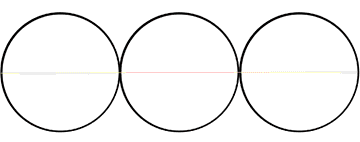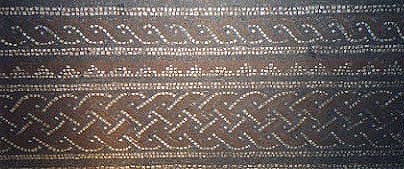
Guilloche is the twisted rope design often used in borders and to frame elements of Roman mosaics. You can draw guilloche freehand, but I decided on a more geometric approach. The design is built up from circles, with smaller circles inside them, as shown in the animation here. You can see all the stages in this process side-by-side

Because the circles are touching, the repeat of the pattern is the same as its height. This is authentic, but Roman mosaics also sometimes have more compact guilloche work - you can get this effect by overlapping the large circles.
To draw the large circles on the board I used a pencil held in a loop in some string. I pinned the string at the centre of the circle to get the required radius.
Once the basic guilloche pattern was on the board, I drew in guidelines for the rows of tile tesserae. To reinforce this, I shaded the outer rows which would be of black tiles. This left five rows in the centre of each strand.

Typically, guilloche borders in Roman mosaics have three (rather than five) rows of tesserae. These might be two rows of one colour and one row of a different colour, or three rows, each in different colour.
As well as designs with two interwoven strands, three or even five strands were also popular (see below). Browse through some of the Roman mosaics featured on this site to compare different uses of guilloche.

Two and five stranded guilloche bands.



